Topics
Category
Era
US–Dakota War of 1862
Though the war that ranged across southwestern Minnesota in 1862 between settler-colonists and a faction of Dakota people lasted for six weeks, its causes were decades in the making. Its effects are still felt today.
In 1851, after the treaties of Mendota and Traverse des Sioux, the US government removed most of the Dakota people living in Minnesota Territory (their homeland, called Mni Sota Makoce in the Dakota language) to a reservation on either side of the Minnesota River. The Treaty of Washington (1858) confined them to a smaller area south of the river.
Being restricted to one place made it hard for Dakota people to practice their traditional lifeways, which involved hunting migratory game and moving their homes seasonally. The terms of the treaties and the work of missionaries focused on forcing them to abandon their culture—in effect, to stop being Dakota. To survive, some adopted European American farming methods, cut their hair, and converted to Christianity. Others resisted assimilation by, for example, continuing to hunt and practice ceremonies. Many assimilated in some ways while resisting in others.
Immigrants flooded into southwestern Minnesota Territory in the 1850s, especially eager to claim land near rivers like the Minnesota. The US government, however, failed to fulfill its treaty obligations to the Dakota. It built few schools, offered insufficient education in farming, and charged exorbitant prices for homesteading goods. Many Dakota people used what money they did receive to pay off inflated debts and fraudulent traders.
By the summer of 1862, Dakota people on the reservation were in desperate straits—many of them starving. Game was scarce. The corn crop of 1861 had been meager. Annuity payments, which would have covered the cost of food and goods, were late, but traders refused to extend credit. Lower Sioux Agency storekeeper Andrew Myrick told the hungry Dakota to “eat grass or their own dung.”
On August 17, the tense situation reached a climax when four Dakota hunters killed five settlers in Acton Township. In the middle of the night, a group of Mdewakanton men persuaded a reluctant Ta Oyate Duta (His Red Nation, also known as Little Crow) to continue the fight against the United States in an all-out war. In response, the Dakota divided into two main factions: the farmers, or “cut hairs,” who argued for peace, and others (particularly young Mdewakanton men) who supported violent resistance.
The following day, Ta Oyate Duta’s party attacked the Lower Sioux Agency and homesteads in Brown and Renville Counties. On August 19 it reached New Ulm, where the townspeople erected a defensive barricade after a protracted skirmish.
The state’s leaders hurried to organize an army from a population already depleted by recruitment for the Civil War. Governor Alexander Ramsey placed Henry Sibley in charge of US forces that engaged the Dakota in battles at Fort Ridgely (August 20 and 22), New Ulm (August 25), Birch Coulee (September 3–4), and Acton, Forest City, Hutchinson, and Fort Abercrombie (September 3–4).
During the six-week conflict, the Dakota participants who chose violent resistance killed more than 600 settlers, including women and children; the number of Dakota casualties is unrecorded. Fewer than 1,000 Dakota, out of a population of more than 7,000, participated. Many saved settlers’ lives; some, like Gabriel Renville, joined a lodge dedicated to peace.
At the war’s final engagement, the Battle of Wood Lake (September 23), Sibley’s forces defeated the Dakota. Ta Oyate Duta and other Mdewakanton fled to Dakota Territory or Canada. On September 26, settlers who had been held hostage or protected by different Dakota factions gathered at a site that came to be known as Camp Release.
After the war, the US government nullified its treaties with the Dakota, dissolved their reservation, and publicly executed thirty-eight Dakota men in Mankato at the largest mass hanging in the nation’s history. Meanwhile, it removed about 1,600 Dakota non-combatants to a concentration camp at Fort Snelling, where they remained imprisoned during the winter of 1862–1863. Though they had not participated in the war, nearly 2,000 Ho-Chunk people living at Blue Earth, along with the Dakota at the fort, were removed the following spring to a reservation in Dakota Territory and, later, Nebraska. The government allowed a few Dakota who had supported peace to stay, including the family of Wakinyanwaste (Good Thunder), who were close to Episcopal Bishop of Minnesota Henry Benjamin Whipple.
The war devastated people throughout south-central Minnesota. Settlers mourned their dead and abandoned claims across southern and western Minnesota. For the Dakota, the grief was deepened by the prospect of exile from their homeland. It wasn’t until the 1880s that exiled families began to return to their relatives who had stayed in Mni Sota Makoce. Together, they built communities at Prairie Island, Shakopee, and the sites of the Upper and Lower Sioux Agencies.
Bibliography
Anderson, Gary Clayton. “Myrick’s Insult: A Fresh Look At Myth and Reality.” Minnesota History 48, no. 5 (Spring 1983): 198–206.
http://collections.mnhs.org/MNHistoryMagazine/articles/48/v48i05p198-206.pdf
–––––– . Massacre in Minnesota: The Dakota War of 1862, the Most Violent Ethnic Conflict in American History. Norman, OK: University of Oklahoma Press, 2019.
Anderson, Gary Clayton, and Alan R. Woolworth, eds. Through Dakota Eyes: Narrative Accounts of the Minnesota Indian War of 1862. St. Paul: Minnesota Historical Society Press, 1988.
Canku, Clifford, and Michael Simon. The Dakota Prisoner of War Letters: Dakota Kaskapi Okicize Wowapi. St. Paul: Minnesota Historical Society Press, 2013.
Carley, Kenneth. The Dakota War of 1862. 2nd ed. St. Paul: Minnesota Historical Society Press, 2001.
Clodfelter, Michael. The Dakota War: The United States Army Versus the Sioux, 1862–1865. Jefferson, NC: McFarland, 1998.
DeCarlo, Peter. Fort Snelling at Bdote: A Brief History. 2nd edition. St. Paul: Minnesota Historical Society, 2020.
Gilman, Rhoda R. Henry Hastings Sibley: Divided Heart. St. Paul: Minnesota Historical Society Press, 2004.
Little Crow (Ta Oyate Duta) to Henry Sibley, September 7, 1862. Quoted in Nathaniel West, The Ancestry, Life, and Times of Hon. Henry Hastings Sibley, LL.D (St. Paul: Pioneer Press Publishing, 1889), 262.
https://archive.org/details/cu31924012533695/page/262/mode/2up
Minnesota Historical Society. The US–Dakota War of 1862.
https://www3.mnhs.org/usdakotawar/
Monjeau-Marz, Corinne. The Dakota Indian Internment at Fort Snelling, 1862–1864. St. Paul: Prairie Smoke Press, 2006.
Westerman, Gwen, and Bruce M. White. Mni Sota Makoce: The Land of the Dakota. St. Paul: Minnesota Historical Society Press, 2012.
Wingerd, Mary Lethert. North Country: The Making of Minnesota. Minneapolis: University of Minnesota Press, 2010.
Related Resources
Primary
Dakota Conflict of 1862 manuscripts collections, 1859–1965
Manuscripts Collection, Minnesota Historical Society, St. Paul
Description: A compilation of small collections of letters, reminiscences, reports, diaries, and similar materials dealing with the US–Dakota War of 1862 and related activities of 1862–1865 in Minnesota and Dakota Territory. They primarily detail the personal experiences of both white and Dakota participants or witnesses during this period.
http://www2.mnhs.org/library/findaids/01166.xml
US–Dakota War of 1862 Oral History Project
Oral History Collection, Minnesota Historical Society, St. Paul
Description: Minnesota Historical Society staff collected dozens of stories from Dakota people throughout Minnesota, the Midwest, and Canada, as well as from settler descendants, in southwestern Minnesota during 2011 and 2012.
http://collections.mnhs.org/cms/display?irn=11007747
United States Office of Indian Affairs. Census of Dakota Indians Interned at Fort Snelling After the Dakota War in 1862. Washington, DC: United States Office of Indian Affairs, [1862].
Secondary
Anderson, Gary Clayton. Little Crow: Spokesman for the Sioux. St. Paul: Minnesota Historical Society Press, 1986.
——— . Kinsmen of Another Kind: Dakota–White Relations in the Upper Mississippi Valley, 1650–1862. St. Paul: Minnesota Historical Society Press, 1997.
Beane, Syd. Ohiyesa: The Soul of an Indian. DVD. St. Paul: Vision Maker Media, 2018.
Munson, Daniel C. "The Gold Standard and the Dakota War of 1862." Financial History no. 145 (Spring 2023): 28–31.
https://fhmagazine.org/financial-history-145-spring-2023/0339007001683198759
Waziyatawin, PhD. What Does Justice Look Like?: The Struggle for Liberation in Dakota Homeland. St. Paul: Living Justice Press, 2008.
Web
Minnesota Humanities Center. Bdote Memory Map.
http://bdotememorymap.org
Related Video
US–Dakota War of 1862
For six weeks in 1862, war raged throughout southwestern Minnesota. There were many causes. The fighting and its aftermath changed the course of the state's history, and descendants of those touched by the war continue to live with the trauma it caused.
All rights reserved
More Information
Articles
Related Images
Gabriel Renville, ca. 1880–1881. This public-domain image was originally obtained, in 2017, from https://www.ndstudies.gov/curriculum/high-school/mni-wakan-oyate/leaders-mni-wakan-oyate.
Hand-sewn, unbleached cotton muslin skirt or petticoat with seven holes near the hem. Mary Schwandt Schmidt's mother made the skirt in the spring of 1862 from the cover of the wagon in which the Schwandt family came to Minnesota. Mary Schwandt Schmidt was wearing the skirt when she was captured during the US–Dakota War of 1862. The holes near the hem are reportedly bullet holes, though the holes no longer retain their circular shape.
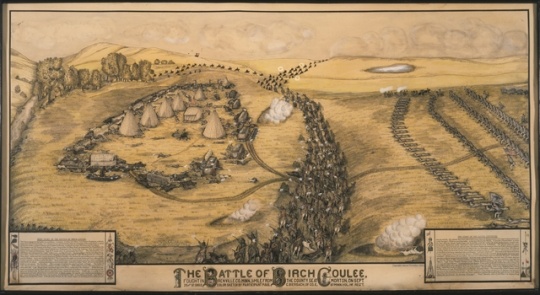
Battle of Birch Coulee
Lithograph interpretation of the Battle of Birch Coulee, 1912.
Public domain
Holding Location
More Information
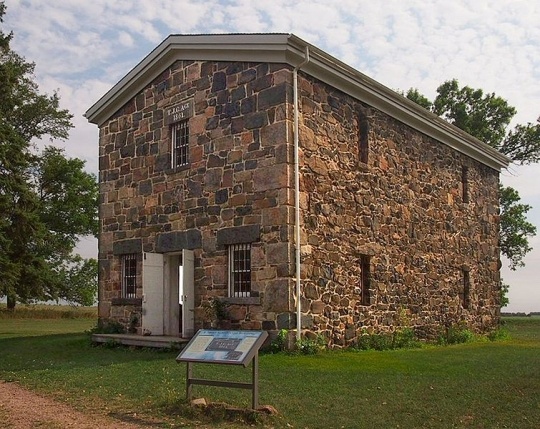
Lower Sioux Agency Warehouse
The Lower Sioux Agency warehouse, 2012. Photographed by Wikimedia Commons user McGhiever on August 31, 2012.
More Information

People escaping from the US–Dakota War of 1862
People escaping from the US–Dakota War of 1862. Photograph by Adrian John Ebell, August 21, 1862.
Holding Location
Articles
More Information
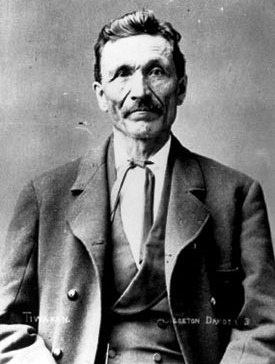
Gabriel Renville
Gabriel Renville, ca. 1880–1881. This public-domain image was originally obtained, in 2017, from https://www.ndstudies.gov/curriculum/high-school/mni-wakan-oyate/leaders-mni-wakan-oyate.
Public domain
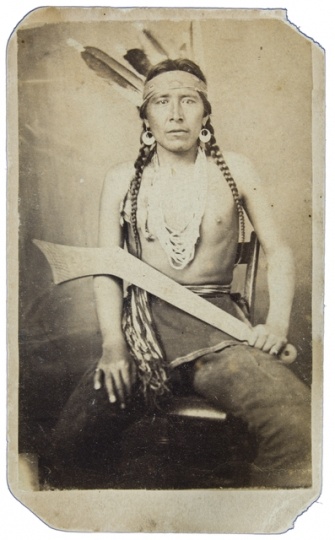
Wambditanka (Big Eagle)
Wambditanka (Jerome Big Eagle), c.1863.
Public domain
Holding Location
More Information
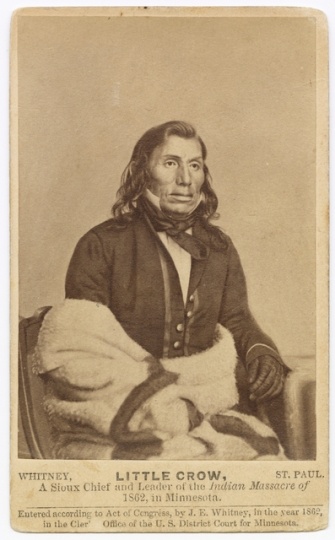
Ta Oyate Duta (His Red Nation, also known as Little Crow)
Ta Oyate Duta (His Red Nation, also known as Little Crow), 1862.
Holding Location
More Information
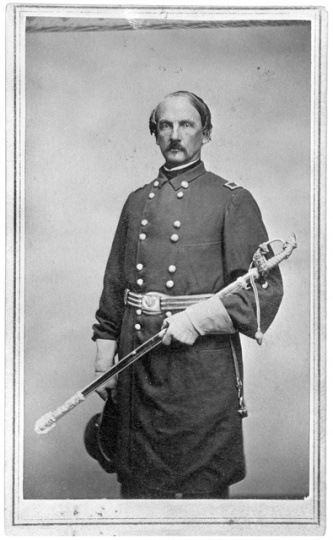
Henry H. Sibley, brigadier general
Henry H. Sibley as a brigadier general in the United States Volunteer Army, 1863.
Holding Location
More Information
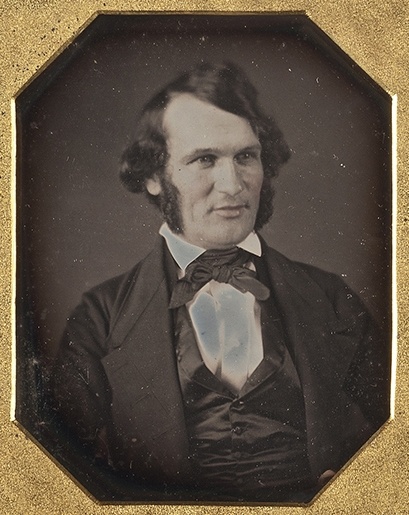
Alexander Ramsey
Alexander Ramsey, ca. 1848.
Public domain
Holding Location
More Information
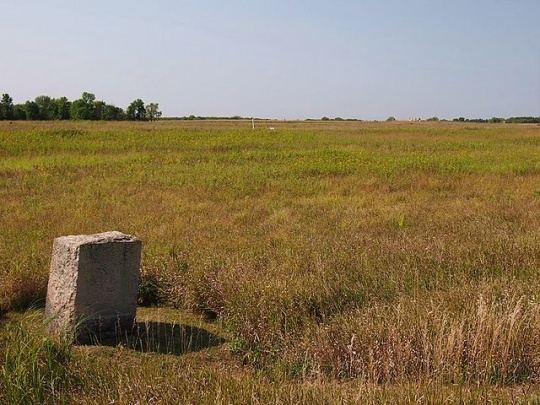
Birch Coulee battlefield monument
Marker erected by the Minnesota Valley Historical Society at the site of the Battle of Birch Coulee in Renville County, Minnesota. View from County Road 2 looking southwest. Photo by Wikimedia Commons user McGhiever, September 1, 2012. CC BY-SA 3.0.
Holding Location
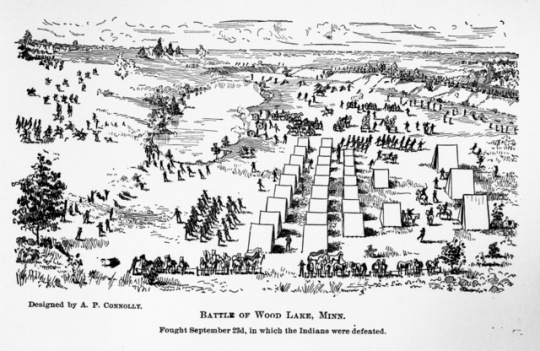
Battle of Wood Lake
Drawing of the Battle of Wood Lake, c.1896. From A thrilling narrative of the Minnesota massacre and the Sioux War of 1862–63 (A.P. Connolly. Chicago, 1896.)
Public domain
Holding Location
More Information
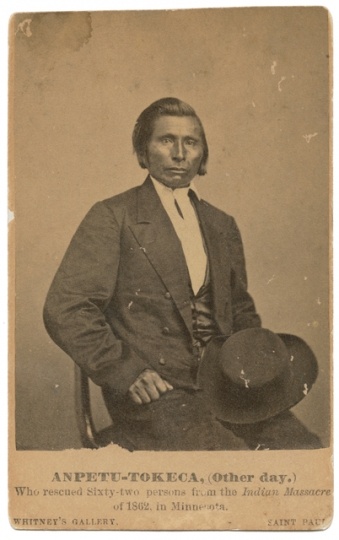
Anpetu Tokeca
Anpetu Tokeca (also known as John Other Day), a Dakota man who aided settler-colonists during the US–Dakota War of 1862.
Holding Location
Articles
More Information
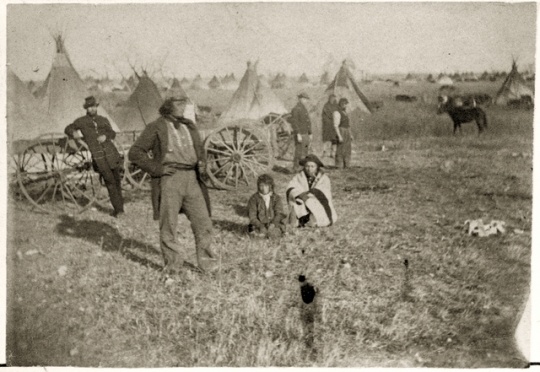
Camp Release
Camp Release, the site of the surrender of hostages after the US–Dakota War of 1862. Photograph by Adrian John Ebell, 1862.
Holding Location
Articles
More Information
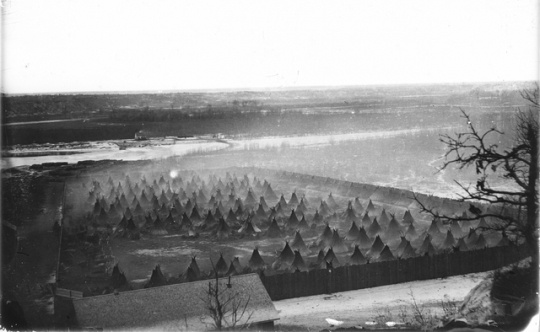
Dakota concentration camp below Fort Snelling
View of the Dakota concentration camp on the river flats below Fort Snelling, c.1862–1863. Photograph by Benjamin Franklin Upton.
Public domain
Holding Location
More Information
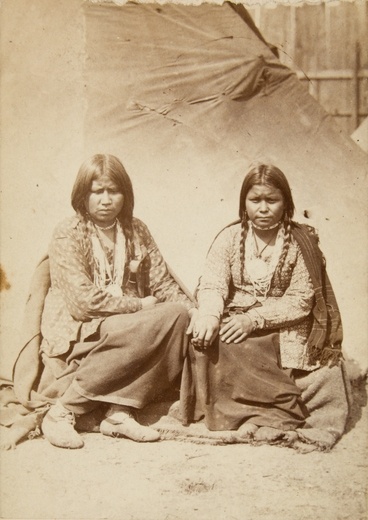
Dakota Women at Fort Snelling concentration camp
Two Dakota women at the Fort Snelling concentration camp, c.1862–1863. Photograph by Joel Emmons Whitney.
Public domain
Holding Location
More Information
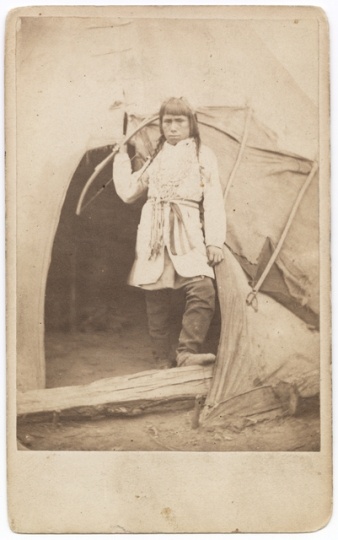
Dakota Boy at Fort Snelling concentration camp
Dakota boy at the concentration camp below Fort Snelling, 1863. Photograph by Whitney’s Gallery.
Public domain
Holding Location
More Information

Muslin skirt with bullet holes
Hand-sewn, unbleached cotton muslin skirt or petticoat with seven holes near the hem. Mary Schwandt Schmidt's mother made the skirt in the spring of 1862 from the cover of the wagon in which the Schwandt family came to Minnesota. Mary Schwandt Schmidt was wearing the skirt when she was captured during the US–Dakota War of 1862. The holes near the hem are reportedly bullet holes, though the holes no longer retain their circular shape.
All rights reserved
Holding Location
Articles
More Information

Double-barrel percussion rifle
Double-barrel percussion rifle reportedly used by Parker J. Pierce during the US–Dakota War of 1862.
All rights reserved
Holding Location
Articles
More Information

Wood bow
A wooden long bow with a fiber string used in the US–Dakota War of 1862.
All rights reserved
Holding Location
Articles
More Information
Related Articles
Turning Point
Mdewakanton men assemble at a soldiers’ lodge on August 17. Later that night, they visit Ta Oyate Duta (His Red Nation, also known as Little Crow) at his home and convince him to lead them in armed resistance against settler-colonists.
Chronology
1851
1858
Summer 1862
August 17, 1862
August 18
August 19
August 20–22
August 22
September 2–3
September 3–4
September 23
September 24
September 26
November 5
December 26
Bibliography
Anderson, Gary Clayton. “Myrick’s Insult: A Fresh Look At Myth and Reality.” Minnesota History 48, no. 5 (Spring 1983): 198–206.
http://collections.mnhs.org/MNHistoryMagazine/articles/48/v48i05p198-206.pdf
–––––– . Massacre in Minnesota: The Dakota War of 1862, the Most Violent Ethnic Conflict in American History. Norman, OK: University of Oklahoma Press, 2019.
Anderson, Gary Clayton, and Alan R. Woolworth, eds. Through Dakota Eyes: Narrative Accounts of the Minnesota Indian War of 1862. St. Paul: Minnesota Historical Society Press, 1988.
Canku, Clifford, and Michael Simon. The Dakota Prisoner of War Letters: Dakota Kaskapi Okicize Wowapi. St. Paul: Minnesota Historical Society Press, 2013.
Carley, Kenneth. The Dakota War of 1862. 2nd ed. St. Paul: Minnesota Historical Society Press, 2001.
Clodfelter, Michael. The Dakota War: The United States Army Versus the Sioux, 1862–1865. Jefferson, NC: McFarland, 1998.
DeCarlo, Peter. Fort Snelling at Bdote: A Brief History. 2nd edition. St. Paul: Minnesota Historical Society, 2020.
Gilman, Rhoda R. Henry Hastings Sibley: Divided Heart. St. Paul: Minnesota Historical Society Press, 2004.
Little Crow (Ta Oyate Duta) to Henry Sibley, September 7, 1862. Quoted in Nathaniel West, The Ancestry, Life, and Times of Hon. Henry Hastings Sibley, LL.D (St. Paul: Pioneer Press Publishing, 1889), 262.
https://archive.org/details/cu31924012533695/page/262/mode/2up
Minnesota Historical Society. The US–Dakota War of 1862.
https://www3.mnhs.org/usdakotawar/
Monjeau-Marz, Corinne. The Dakota Indian Internment at Fort Snelling, 1862–1864. St. Paul: Prairie Smoke Press, 2006.
Westerman, Gwen, and Bruce M. White. Mni Sota Makoce: The Land of the Dakota. St. Paul: Minnesota Historical Society Press, 2012.
Wingerd, Mary Lethert. North Country: The Making of Minnesota. Minneapolis: University of Minnesota Press, 2010.
Related Resources
Primary
Dakota Conflict of 1862 manuscripts collections, 1859–1965
Manuscripts Collection, Minnesota Historical Society, St. Paul
Description: A compilation of small collections of letters, reminiscences, reports, diaries, and similar materials dealing with the US–Dakota War of 1862 and related activities of 1862–1865 in Minnesota and Dakota Territory. They primarily detail the personal experiences of both white and Dakota participants or witnesses during this period.
http://www2.mnhs.org/library/findaids/01166.xml
US–Dakota War of 1862 Oral History Project
Oral History Collection, Minnesota Historical Society, St. Paul
Description: Minnesota Historical Society staff collected dozens of stories from Dakota people throughout Minnesota, the Midwest, and Canada, as well as from settler descendants, in southwestern Minnesota during 2011 and 2012.
http://collections.mnhs.org/cms/display?irn=11007747
United States Office of Indian Affairs. Census of Dakota Indians Interned at Fort Snelling After the Dakota War in 1862. Washington, DC: United States Office of Indian Affairs, [1862].
Secondary
Anderson, Gary Clayton. Little Crow: Spokesman for the Sioux. St. Paul: Minnesota Historical Society Press, 1986.
——— . Kinsmen of Another Kind: Dakota–White Relations in the Upper Mississippi Valley, 1650–1862. St. Paul: Minnesota Historical Society Press, 1997.
Beane, Syd. Ohiyesa: The Soul of an Indian. DVD. St. Paul: Vision Maker Media, 2018.
Munson, Daniel C. "The Gold Standard and the Dakota War of 1862." Financial History no. 145 (Spring 2023): 28–31.
https://fhmagazine.org/financial-history-145-spring-2023/0339007001683198759
Waziyatawin, PhD. What Does Justice Look Like?: The Struggle for Liberation in Dakota Homeland. St. Paul: Living Justice Press, 2008.
Web
Minnesota Humanities Center. Bdote Memory Map.
http://bdotememorymap.org




















